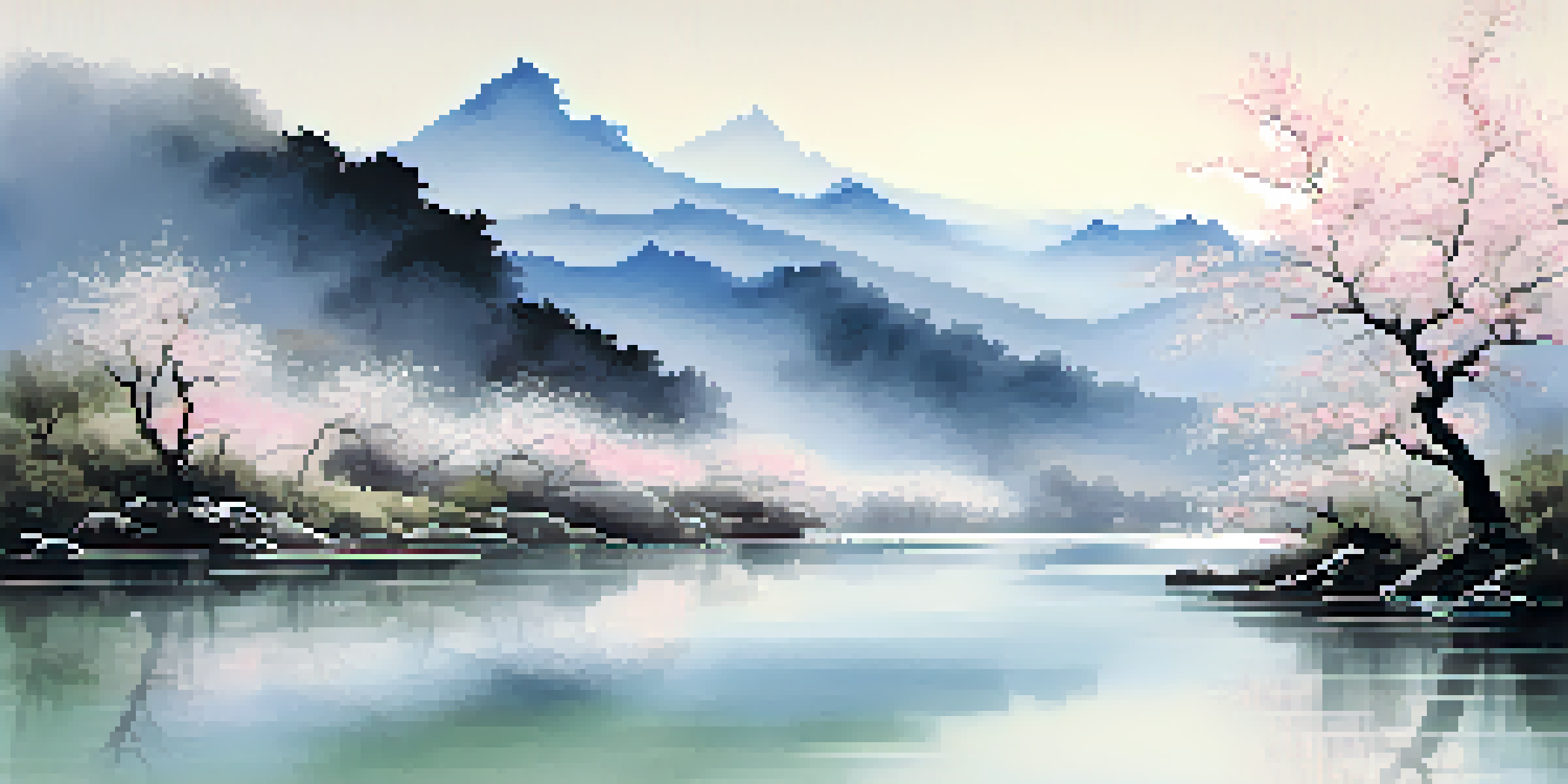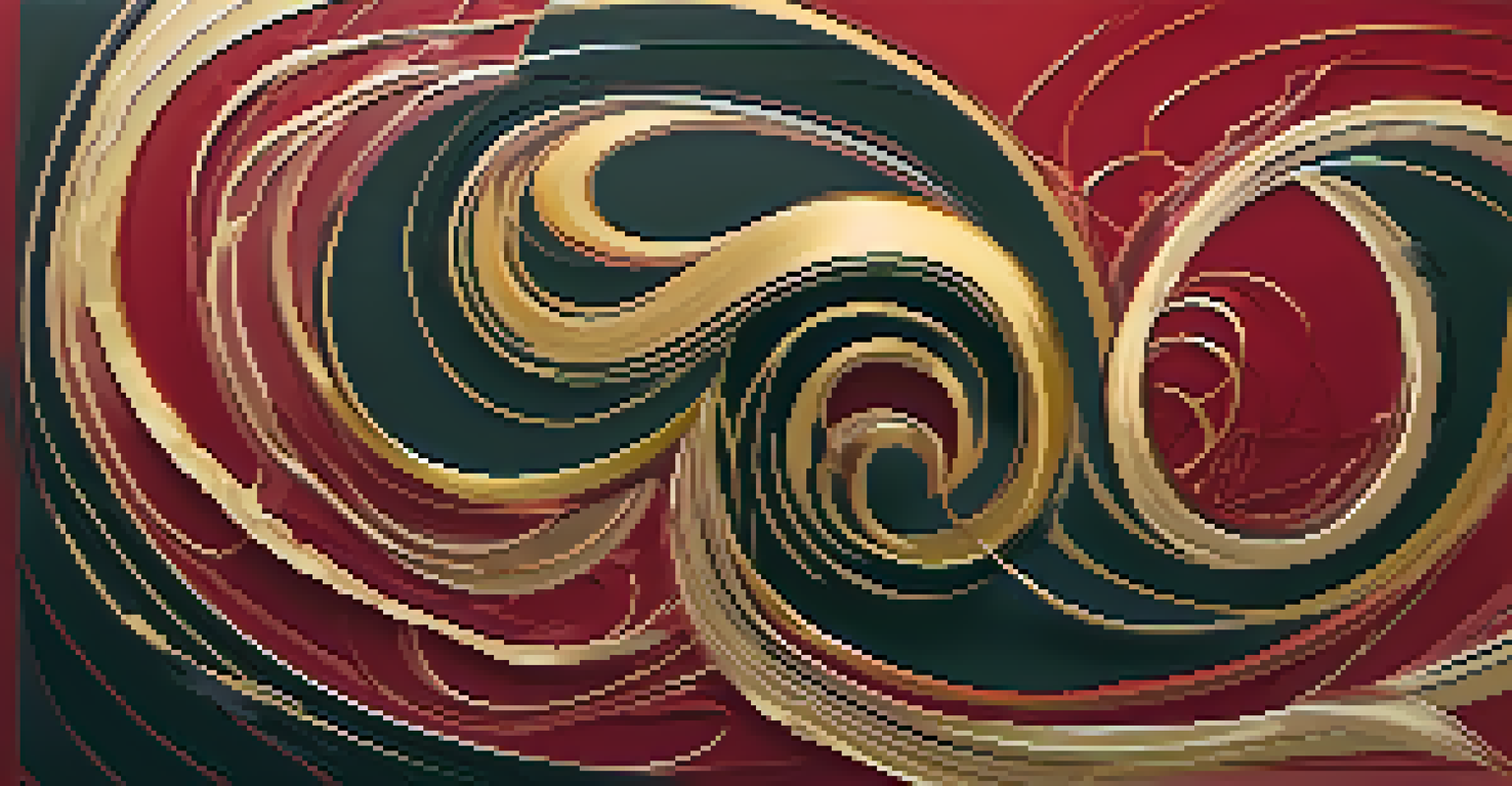Eastern Art Techniques in Contemporary Western Art

Understanding Eastern Art Techniques and Their Roots
Eastern art techniques, steeped in rich traditions, often emphasize harmony, balance, and nature. These principles can be traced back to ancient philosophies, such as Taoism and Buddhism, which encourage a deep connection with the world around us. Artists in Eastern cultures have historically employed methods like ink wash painting and calligraphy, focusing on the fluidity of brushwork and the expressive potential of simplicity.
Art is a way of expressing the inexpressible.
In contrast, Western art has evolved through various movements, often prioritizing realism and perspective. However, the two worlds have been converging, especially in recent decades, as Western artists become increasingly interested in the spiritual and philosophical dimensions of Eastern art. This fusion invites a dialogue that enriches both traditions and broadens the artistic palette.
By understanding these foundational techniques and philosophies, contemporary Western artists can draw inspiration from Eastern practices, creating works that resonate on multiple levels. This blending of styles not only enhances their creativity but also offers viewers a fresh perspective on familiar themes.
The Influence of Calligraphy in Modern Art
Calligraphy, particularly from East Asian cultures, is more than just beautiful writing; it's an art form that embodies rhythm and movement. In contemporary Western art, this fluidity is being reinterpreted through various mediums, including painting and sculpture. Artists like Julie Mehretu have embraced calligraphic elements, creating dynamic works that reflect both chaos and harmony.

The brushstrokes common in calligraphy can evoke emotion and energy, qualities that many contemporary artists strive to achieve. By integrating these elements, Western artists are able to express complex narratives and feelings that resonate deeply with audiences. The motion of the brush can serve as a metaphor for the artist's journey, inviting viewers to engage with the work on a personal level.
Eastern and Western Art Fusion
Contemporary artists are blending Eastern and Western techniques, creating innovative works that celebrate cultural diversity.
Moreover, the meditative aspect of calligraphy encourages artists to slow down and reflect, contrasting with the fast-paced nature of modern life. This practice fosters a deeper connection to their work, allowing for a more authentic expression that honors both their own culture and the Eastern traditions they draw from.
Exploring Ink Wash Techniques in Contemporary Works
Ink wash painting, a hallmark of Eastern art, utilizes simple materials to create stunningly complex images. This technique's emphasis on spontaneity and fluidity has attracted Western artists looking to break free from rigid structures. The works of artists like Mark Tobey, who blended ink wash with abstract expressionism, demonstrate how this method can yield captivating results.
Art enables us to find ourselves and lose ourselves at the same time.
The beauty of ink wash lies in its ability to convey emotion through minimalism. Artists are encouraged to embrace imperfection and embrace the unexpected, mirroring the unpredictability of life itself. By applying this technique, contemporary artists can explore themes of transience and nature, evoking a sense of peace and introspection in their audiences.
Incorporating ink wash into modern practices also challenges traditional Western notions of composition. The use of negative space, a core principle in Eastern art, invites viewers to contemplate what is not present, creating an interactive experience that fosters reflection and dialogue.
The Role of Nature in Eastern and Western Art
Nature has long been a central theme in both Eastern and Western art, but the approach to its representation varies significantly. Eastern art often embodies a sense of reverence for nature, portraying it as a vital force that connects all living things. In contrast, Western art has at times focused more on the human experience and its impact on the environment.
Contemporary Western artists are increasingly turning to Eastern perspectives, showcasing nature as a partner in the creative process. By adopting practices like plein air painting—capturing scenes outdoors—they can create works that reflect an intimate relationship with the environment. Artists such as Ai Weiwei have used natural elements to provoke thought and challenge societal norms.
Calligraphy's Modern Influence
The fluidity of calligraphy is being reinterpreted in Western art, inspiring artists to explore complex narratives through brushwork.
This shift invites a broader conversation about humanity's place within the natural world. As artists explore these themes, they engage audiences in contemplating ecological issues, fostering a sense of responsibility and connection to the landscapes that shape our lives.
Symbolism and Its Evolution Across Cultures
Symbolism plays a pivotal role in both Eastern and Western art, yet the meanings and interpretations can differ widely. In Eastern art, symbols often convey philosophical meanings, such as the lotus representing purity and enlightenment. Understanding these symbols can deepen the appreciation of the artwork and its cultural context.
Western artists are beginning to weave these Eastern symbols into their works, creating a rich tapestry of meaning that resonates with diverse audiences. For example, incorporating the yin-yang symbol can invite viewers to reflect on balance and duality, concepts that transcend cultural boundaries. This blending of symbolism fosters a greater understanding of shared human experiences.
As artists experiment with these symbols, they challenge the viewer to think critically about their own interpretations. This cross-cultural exchange enriches both traditions, encouraging dialogue that transcends geographical and ideological divides.
Contemporary Artists Merging Eastern and Western Techniques
Many contemporary artists are at the forefront of merging Eastern and Western techniques, creating a new genre that defies categorization. For instance, artists like Kehinde Wiley incorporate traditional Eastern styles with modern themes, challenging expectations and celebrating cultural diversity. This innovative approach not only expands artistic possibilities but also reflects the interconnectedness of our globalized world.
These artists often draw inspiration from their own cultural backgrounds, blending elements from both traditions to create unique narratives. By doing so, they invite viewers to engage with their heritage and foster a deeper appreciation for the beauty found in diversity. This cross-pollination of ideas enriches the art community and encourages collaboration across cultures.
Nature's Central Role in Art
Both Eastern and Western art emphasize nature, but modern artists are increasingly portraying it as a partner in the creative process.
Moreover, this fusion can serve as a powerful tool for social commentary, addressing contemporary issues such as identity, migration, and belonging. By intertwining techniques and themes from Eastern and Western art, these artists are not just creating visually stunning works but also sparking meaningful conversations about our shared humanity.
The Future of Art: A Global Perspective
As the art world continues to evolve, the blending of Eastern and Western techniques presents exciting possibilities for the future. Artists are increasingly embracing globalization, using their platforms to showcase diverse voices and perspectives. This shift has the potential to create a more inclusive art landscape that values every culture's contributions.
In this new era, technology plays a crucial role in facilitating cross-cultural exchanges, allowing artists to collaborate and share their work with a global audience. Virtual exhibitions and social media platforms have made it easier for artists to connect, fostering a sense of community that transcends borders. This interconnectedness is shaping a new generation of artists who are unafraid to experiment with hybrid styles.

Ultimately, the future of art lies in its ability to adapt and innovate while honoring the past. By continuing to explore and merge Eastern and Western techniques, artists can create works that not only captivate but also inspire, reflect, and challenge us to think about the world we inhabit.